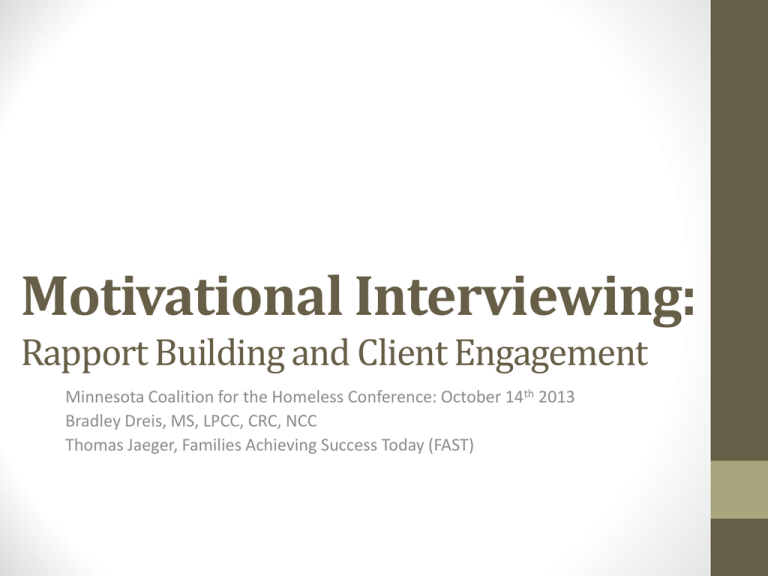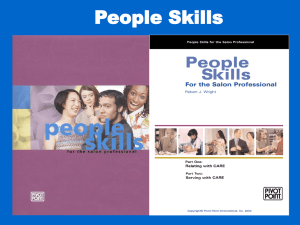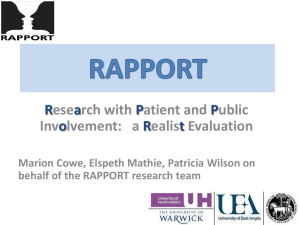Motivational Interviewing: Rapport Building and Client Engagement
advertisement

Motivational Interviewing: Rapport Building and Client Engagement Minnesota Coalition for the Homeless Conference: October 14th 2013 Bradley Dreis, MS, LPCC, CRC, NCC Thomas Jaeger, Families Achieving Success Today (FAST) Introduction • Bradley Dreis • E-mail: BDreis@GoodwillEasterSeals.org • LPCC (Licensed Professional Clinical Counselor) • CRC (Certified Rehabilitation Counselor) • NCC (National Certified Counselor) • History • • • • • Psychotherapist at Goodwill/Easter Seal’s Working Well Mental Health Clinic Mental Health & Motivational Interviewing consultant to the FAST program Motivational Interviewing trainer for Goodwill/Easter Seals of MN Vocational Evaluator Case Manager Introduction • Thomas Jaeger • E-mail: Tjaeger@GoodwillEasterSeals.org • SACIT (substance abuse Counselor in training) • BS Vocational Rehab UW Stout • Concentration in Psych-Rehab • History • • • • Employment Support Consultant to the FAST program Motivational Interviewing coach for Goodwill Easter seals Transitional living skills counselor and Client Advocate Catholic Charities Chemical Dependency counselor residential treatment facility Introduction • A few considerations before we begin: • Motivational Interviewing will be referred to as “MI” throughout the remainder of this presentation. • MI isn’t meant to be delivered in short one-hour segments, so it is assumed that we have all had at least some previous MI training. • Today’s goal is to provide a few new ideas/strategies to assist you and your clients with making positive changes. Introduction • A Show of Hands: How familiar are you with MI? • • • • 1. No familiarity 2. Brief surface-level introduction 3. Intensive training over multiple days 4. Intensive training(s) and broad familiarity with periodic use • 5. Extensive familiarity: Use it often; Maybe even train others Founders of MI • William R. Miller, PhD • Wrote first MI article in 1983 • Began work in chemical dependency field • Emeritus Distinguished Professor of Psychology and Psychiatry at the University of New Mexico • Stephen Rollnick, PhD • Clinical psychologist • Professor of Health Care Communication in the School of Medicine, at Cardiff University, Wales, United Kingdom Definitions & Key Concepts • Brief Refresher of MI Definitions and Concepts to Assist with Remainder of Presentation • Motivational Interviewing (Lay definition) • Motivational Interviewing is a collaborative conversation style for strengthening a person’s own motivation and commitment to change. (Miller & Rollnick, 2013) Definitions & Key Concepts • Change Talk • Any client speech that favors movement toward a particular change goal. • Sustain Talk • Any client speech that favors status quo rather than movement toward a change goal. Definitions & Key Concepts • Self-Perception Theory • "Individuals come to know their own attitudes, emotions and internal states by inferring them from observations of their own behavior and circumstances in which they occur”. (Bem, 1972) • Or…The more somebody verbalizes a position (either positive or negative), the more s/he will commit to it. Definitions & Key Concepts • Reactance Theory • The natural human tendency to reassert one’s freedom when it appears to be threatened. …even if it hurts them. Definitions & Key Concepts • OARS • An acronym for four basic client-centered communication skills. • O: Open questions • A: Affirmations • R: Reflections • S: Summary Definitions & Key Concepts • Spirit • The underlying set of mind and heart within which MI is practiced. • Partnership • Acceptance • Compassion • Evocation Definitions & Key Concepts • Deceptive Simplicity • Many MI concepts appear easy at first glance, but take practice to master and perform intentionally. Rapport Building & Client Engagement • Practical MI Strategies/Techniques for Rapport Building & Client Engagement VS Rapport Building & Client Engagement • 1. Nobody is in a Power Position. • Client’s input is crucial (Instant engagement!) • Clients are individuals, not “populations” • Trouble occurs when we start thinking “I know my typical client population” because we then make assumptions. • Clients are perceptive of our assumptions and will deem us to be “just another professional” in much the same manner. Rapport Building & Client Engagement • 1. Nobody is in a Power Position. …continued • Taking a few minutes to better understand a client’s situation can go a long way with building rapport and maintaining engagement. • Example of an initial introduction to an appointment: • A: “Hello. Did you bring your ID? We should probably get started on updating your plan right away. It’s due today and I only have a half hour to get it all done”. • B: “Hello. How was your weekend? We’ll need to update your plan today, so I’m interested to know if there have been any changes since we last met”. Rapport Building & Client Engagement • 1. Nobody is in a Power Position. …continued • Both people are working collaboratively towards a goal. Both people are responsible for doing their part to attain the goal. • The practitioner is the “expert” regarding professional knowledge. The client is the “expert” regarding their own life and behaviors. • Both need to work together for maximum benefit. • Recognizing that we aren’t expected to be the expert and fully responsible for a client’s success can be incredibly freeing. This decreases staff burnout. Rapport Building & Client Engagement • 2. Act like you have 30 minutes with a client and it will take all day. Act like you have all day with a client and it will take 30 minutes. • Q: “What if I need to meet certain outcome numbers and I don’t get much time with my clients?” • A: It’s important to recognize that some clients are going to need additional time. This can’t be forced. Some may not even be appropriate for your program. Rapport Building & Client Engagement • 2. Act like you have 30 minutes with a client and it will take all day. Act like you have all day with a client and it will take 30 minutes. …continued • We want to “fish” WITH clients, not be relied upon by them. • “Walking” with others instead of solving their problems for them shows that we believe in their ability to be independent and resourceful. Rapport Building & Client Engagement • 3. Judge if ambivalence is present. • Use OARS to explore ambivalence while listening for change talk. • Always end with Positive Change Talk. • Even 1% will work!!! …If no ambivalence, then no MI. Rapport Building & Client Engagement • 4. What if there is no ambivalence? • Use the Hypothetical Question with a focus on potential change talk. • Use Open-Ended questions to explore and maybe start a new way of thinking. • Keep in mind that this may be the first time that the client is actively thinking through a problem. This may cause some initial resistance. Rapport Building & Client Engagement • 5. There are always “givens” that can be counted upon to encourage change talk. Examples: • The client showed up and is complying with the program. • MI works with both mandated and non-mandated clients. • The client has established goals. …even if very little progress is being made. **Have you recognized any “givens” with your clients that are sure to elicit change talk? Rapport Building & Client Engagement • 6. “Ambivalence” means that 2 sides of change exist. We want clients to advocate for the side of positive change. • Things to watch for: • The Righting Reflex • Self-Reactance Theory Staff: “Smoking costs so much. You can’t afford it”. Client: “Sure I can. I can buy a cheaper brand. I could also skip one AA meeting per week and buy a pack with the saved bus fare. Staff: “Smoking causes cancer. It will kill you!” Client: “I don’t think so. My Grandfather lived 90 years and smoked every day!” Rapport Building & Client Engagement • 7. Affirmations are HUGE! • We may be one of the only people in a client’s life that is in a position to compliment them. • There are lots of “givens” that can be used with affirmations. • Ex. Arrived on time, Appearance, Completed homework, etc. …others? Rapport Building & Client Engagement • 7. Affirmations are HUGE! …continued • Leading off a meeting with an affirmation is a great way to start positive communication and encourage engagement and rapport. “Did you bring your activity log? I hope so because it’s due by 5:00 today. Do you need another bus pass?” OR “You arrived on time for the third meeting in a row! I know it’s been hard to coordinate your son’s new childcare schedule. You have really done an excellent job prioritizing your responsibilities. Rapport Building & Client Engagement • 8. Arguments should never occur when following the Spirit of MI. (…but we do like emotional resistance!) • Arguments are 100% ineffective • Which person would you rather work with? • Which one is more passionate? • Which one cares more about the situation/circumstance? Rapport Building & Client Engagement • 8. Arguments should never occur when following the Spirit of MI. (…but we do like emotional resistance!) …continued • We want to Roll With Resistance • We don’t want to waste or discourage their passion! • Remember that resistance isn’t about us, it’s about their situation or circumstances • We can often agree with their frustration, even when their statements are initially directed at us. • It is possible to show empathy without condoning or agreeing with client behaviors. • Ex. “Yea, it is annoying to be asked to fill out more paperwork. A lot of these forms do ask similar questions. I certainly understand your frustration”. Rapport Building & Client Engagement • 9. “What can I do when a client just isn’t making progress and is sitting on my case load for an extended period of time?” • Often, a client says that they are motivated and appears to follow through with requirements, but they never actually make progress. • Is the client truly motivated to change, or do they feel that they are accomplishing something by merely participating in the “process” of change? • Ex. A job searcher that seems to sabotage interviews because they consider the job placement process as “work” without the responsibilities of an actual job. Rapport Building & Client Engagement • 9. “What can I do when a client just isn’t making progress and is sitting on my case load for an extended period of time?” …continued • It may help to assume that the client has low motivation or doesn’t feel that the change is of high importance. • Hypothetical and Open-Ended questions can help to explore ambivalence and potentially evoke change talk. Rapport Building & Client Engagement • 10. It’s OK to give advice, but make sure that it is the client’s decision to pursue the advice. • We are professionals, but we shouldn’t be expected to have ALL of the answers. • Ex. I specialize in mental health treatment, but am not an expert on solving housing issues even though unstable housing is often correlated with increased symptoms. Rapport Building & Client Engagement • 10. It’s OK to give advice, but make sure that it is the client’s decision to pursue the advice. …continued • Use EPE (Elicit, Provide, Elicit) to provide information while still maintaining the Spirit of MI. • We all often look to blame others for negative outcomes, even if others are trying to help us. Rapport Building & Client Engagement • 10. It’s OK to give advice, but make sure that it is the client’s decision to pursue the advice. …continued • Which of these clients will likely: • follow through with the advice? • blame the practitioner for an unfavorable result? • feel more engaged in the change process? “You should tell your boss that you didn’t mean to yell at her. Maybe then she will give you back your job?” OR “Do you mind if I share a suggestion that has worked for a few of my past clients? Some of them have successfully saved their job by apologizing for mistakes”. Audience Findings with MI Strategies • Have you had success with building rapport and keeping clients engaged using MI strategies? Feedback/Questions Further Resources • http://www.motivationalinterview.org/ References • Miller, W.R., & Rollnick, S. (2013) Motivational Interviewing (3rd ed.). New York, NY: The Guilford Press. • Bem, D. J., Self Perception Theory. In L. Berkowitz (ed). Advances in Experimental Social Psychology, Vol 6, 1972.







